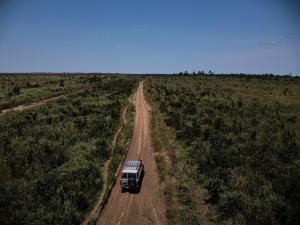DRC: The great lengths that polio vaccinators go to reach every last child
By foot, boat and bicycle, thousands of volunteer vaccinators in the Democratic Republic of Congo (DRC) go to extraordinary efforts, sometimes at personal risk, to help eradicate polio.
As the canoe, made of wood worn smooth from its many voyages, rocks from side to side, bending around the curves of the river Kwilu, Tangomo Tansia keeps a tight grip on the blue and white box that sits on his lap. Onlookers, observing his protective hold and concentrated expression, might assume the box contains money, gold or some other expensive goods. The box, however, is full of polio vaccines, kept at below zero temperatures with ice packs to maintain potency.
Community health workers like Tansia see their vaccine boxes as the most precious cargo. Stowed on planes and ferries, in jeeps, cars and canoes, strapped down to the backs of motorcycles and bicycles, or carried in their arms as they walk on their own two feet, these dedicated volunteers go to extraordinary lengths to make sure the vaccines reach the furthest corners of their country.
Stopping polio transmission in DRC has been challenging. The country is vast and covers an impressive array of terrains, from dense forest to mountains, which though breathtaking, are difficult to cross. Travel is further complicated by a small road network, which despite its size, equates to that of western Europe.
Conflict and insecurity also led to internal displacement, making some areas inaccessible. In these hard-to-reach areas, health services are particularly weak.
Despite these challenges, the DRC’s polio programme trailblazed a number of innovations and measures to overcome these challenges, which have since been used by other countries. ‘Days of tranquility’ were negotiated, allowing humanitarians to transport vaccines to usually inaccessible conflict-affected areas by air and road convoys.
Another huge contribution has been the tireless work of thousands of volunteers like Tansia, whoover the last decade have vaccinated millions of children against polio in some of the most remote areas of the country.
Their task is not easy, whether by canoe, bicycle, motorbike or on foot. Sailing on the surging Congo river from the capital Kinshasa to Bandundu (some 400 km away), strong currents may capsize the boats, with a risk of crocodile attacks further upstream towards Mbandaka.
Last year, Tansia, who comes from Kikwit but works 135 km away in Bandundu, almost drowned when his canoe came close to capsizing. “That was the scariest experience of my life,” he says. The boat was overloaded, “We were around 30 passengers in the canoe and there was luggage as well,” explains Tansia. With the canoe’s sudden lurch, it launched its load into the Kwilu river, including Tansia and all his possessions.
Floating in the water, he watched his bike and bag sink to the bottom of the river bed. “I was very sad to lose them,” he sighs. Tansia could not be deterred from his mission, however. He kept hold of the vaccine box. “I was happy because I didn’t lose it,” he says with pride. “When we regained control of the canoe, I carried on the journey with the vaccines and they were used in that polio campaign.” His goal is to ensure that enough children in DRC are vaccinated to protect the whole population against polio.
After 1,000 children were infected in 1995 in Mbuji-Mayi, in the largest recorded polio outbreak DRC has seen, a vast Rotary-funded vaccination campaign began. Between 2001 and 2005, DRC quickly interrupted endemic wild polio, but faced repeated importations from Angola between 2006 to 2011. The country was eventually declared free of wild polio in November 2015, with over 250 million children vaccinated in total.
But there is still a long way to go.
At least 90% of children should be fully vaccinated in order to make sure that the disease doesn’t spread among the population if it is reintroduced, and in order to limit the spread of a vaccine-derived version of the virus.
Although administrative data reports nearly 80% of children in the country are fully immunized against polio, the country is responding to recurrent outbreaks of circulating vaccine-derived poliovirus (cVDPV), which flourishes where immunization rates are lowest. cVDPV outbreak responses are complicated by other disease outbreaks, including Ebola.
The journeys that volunteers like Tansia undertake are vital for reaching all communities with vaccines, no matter how far and difficult they are to access. These volunteers not only deliver polio vaccines though, they also deliver other health services, including Vitamin A, deworming tablets and insecticide-treated bed nets. More recently, they have been supporting raising awareness around COVID-19 in their communities.
“We are a bridge between the population and the health center,” says Tansia.
“It is our duty to make our contribution to the well-being of our community… to protect our children against polio," he adds as he gently drops a dose of polio vaccine into the mouth of one-year-old Ruth Make. "Without doubt, they are the future of tomorrow.”
Emergency Communications Officer
Tel : +243 81 715 1697
Office : +47 241 39 027
Email: kabambie [at] who.int
Polio Communications Officer
Email: habdallah [at] who.int
Tel: +201123000665 (WhatsApp)
